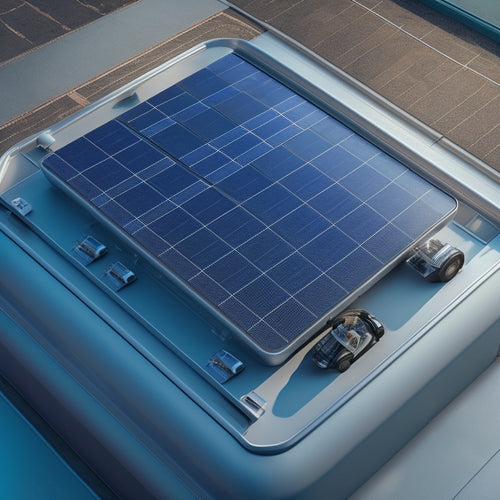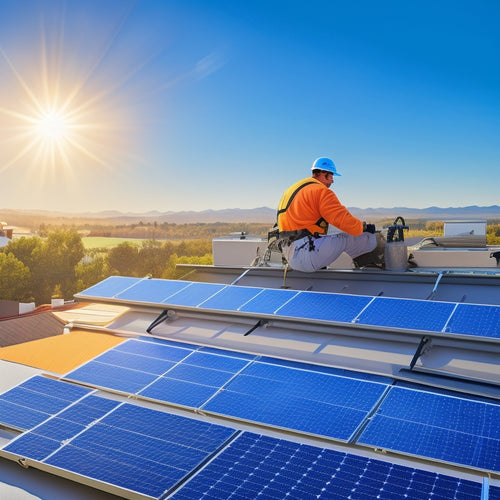
3 Essential Steps for a Successful Solar PV System Design
Share
When designing a successful solar PV system, you'll want to follow three essential steps. First, assess the site conditions by evaluating the property layout, orientation, and shading analysis to guarantee maximum energy production. Next, select ideal components, such as high-efficiency modules and inverters with high maximum power point tracking efficiency, to maximize energy output. Finally, confirm efficient installation by planning and executing the physical deployment, choosing the right mounting strategies, and verifying secure electrical connections. By getting these fundamentals right, you'll be well on your way to revealing the full potential of your solar PV system - and that's just the beginning.
Key Takeaways
- Assess site conditions, including property layout, shading, topography, and local building codes, to ensure optimal system performance.
- Select high-efficiency solar PV components, including modules and inverters, that meet energy needs and provide a strong return on investment.
- Plan and execute an efficient installation, considering roof orientation, shading, and obstructions, to maximize energy production.
- Ensure secure electrical connections, proper cable sizing and routing, and correct installation of inverters and balance-of-system components.
- Verify that the system design meets energy needs, is cost-effective, and complies with local building codes and grid connection requirements.
Assessing Site Conditions
When evaluating site conditions for a solar PV system, you're looking at the big picture - literally. You need to reflect on the entire property, factoring in its layout, surroundings, and environmental elements that may impact system performance.
Site orientation is vital, as it affects the amount of sunlight your solar panels will receive. A south-facing orientation is ideal, but you can still achieve peak energy production with east- or west-facing installations.
A thorough shading analysis is also important. You'll need to identify any obstacles that could cast shadows on your solar panels, such as trees, buildings, or chimneys. This analysis will help you determine the best placement and tilt for your panels to maximize energy output.
Additionally, you should assess the site's topography, soil conditions, and local building codes to guarantee a safe and compliant installation. By carefully evaluating these site conditions, you'll be able to design a solar PV system that meets your energy needs and provides a strong return on investment.
Selecting Optimal Components
With a thorough understanding of the site conditions, you can now focus on selecting the ideal components for your solar PV system. This involves choosing high-efficiency modules that maximize energy production while minimizing space requirements.
Consider modules with high module efficiency ratings to guarantee peak energy conversion. Moreover, assess the compatibility of modules with your system's voltage and current requirements.
Inverter selection is another critical aspect of component selection. You'll need to choose an inverter that can handle the system's maximum power output while providing a high efficiency rating.
Look for inverters with a high maximum power point tracking (MPPT) efficiency to guarantee maximum energy harvesting. In addition, consider the inverter's compatibility with your grid connection and monitoring requirements.
Ensuring Efficient Installation
As you shift from component selection to installation, it's essential that you carefully plan and execute the physical deployment of your solar PV system to guarantee ideal energy production. A well-planned installation guarantees that your system operates at maximum efficiency, minimizing energy losses and reducing maintenance costs.
When it comes to installation techniques, you should consider factors such as roof orientation, shading, and obstructions. Confirm that your installation team is experienced and trained to handle the unique challenges of your site.
Mounting strategies, such as fixed-tilt or tracking systems, can greatly impact energy production. Choose a mounting strategy that optimizes energy output while minimizing installation costs.
Additionally, confirm that all electrical connections are secure, and cables are properly sized and routed. Proper installation of inverters, combiner boxes, and other balance-of-system components is vital to system performance.
Frequently Asked Questions
How Long Does a Typical Solar PV System Last?
You're investing in a solar PV system, and you want to know how long it'll last. Typically, a solar panel's lifespan ranges from 25 to 30 years, with degradation rates averaging around 0.5% to 1% per year, ensuring a significant portion of its initial power output remains.
Can Solar Panels Be Installed on a Metal Roof?
You're wondering if solar panels can be installed on a metal roof? Yes, you can! Metal roof benefits include durability and water-tightness, but installation considerations, like specialized mounting systems and potential corrosion, must be carefully addressed to guarantee a successful setup.
Are Solar PV Systems Resistant to Natural Disasters?
You'll be relieved to know that solar PV systems are designed with solar resilience in mind, incorporating disaster preparedness features to withstand natural disasters, ensuring your investment remains safe and functional even in the face of extreme weather events.
Can I Expand My Solar PV System in the Future?
You can easily expand your solar PV system in the future by ensuring system compatibility and planning for future upgrades, allowing you to seamlessly add more panels or inverters as your energy needs grow.
Are There Any Solar PV System Maintenance Requirements?
As you nurture your solar PV system, remember it's like tending a garden - regular care guarantees blooms of efficiency. You'll need to clean those solar panels to let sunlight shine, and monitor system performance to detect any wilting issues, making certain your investment thrives.
Conclusion
By following these 3 essential steps, you'll be well on your way to designing a successful solar PV system that meets your energy needs. For instance, consider a commercial building in California that requires 500 kW of power. By evaluating the site's irradiance and shading, selecting ideal components like high-efficiency panels, and ensuring efficient installation with a single-axis tracker, you can achieve an annual energy yield of 750,000 kWh - enough to power the entire building and even feed excess energy back into the grid.
Related Posts
-

Essential Accessories for Heavy Riders of E-Bikes
As a heavy rider of an e-bike, you need specialized gear that caters to your unique needs. Start with safety essentia...
-

Top Solar Panels for Car Battery Maintenance
When selecting top solar panels for car battery maintenance, consider high-efficiency models with high wattage output...
-

3 Essential Steps for Solar Electricity Installation
To guarantee a successful solar electricity installation, you'll need to follow three essential steps. First, assess ...


